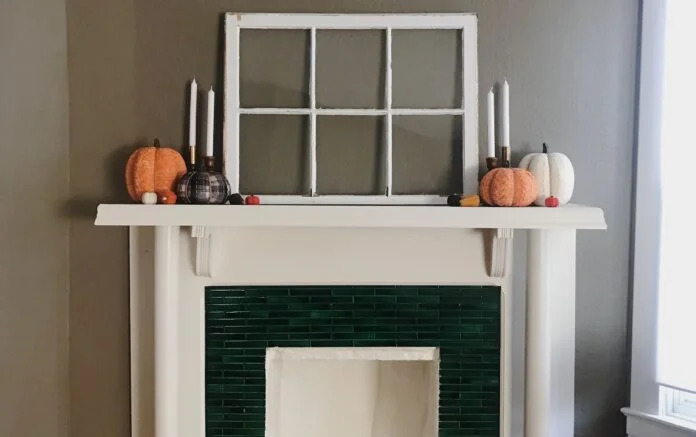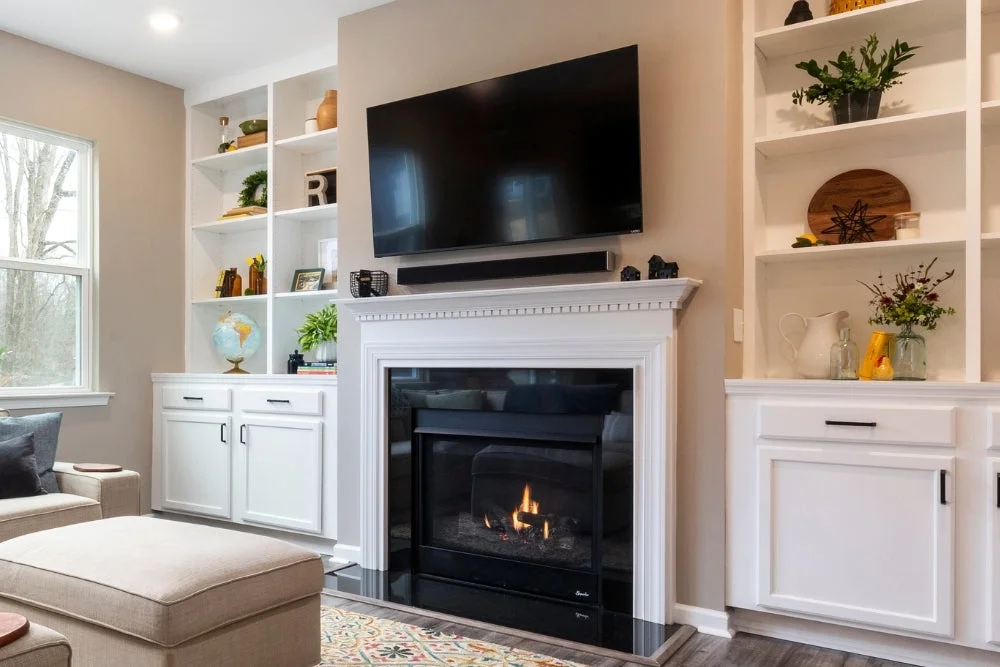Building a false wall is a great way to create the illusion of a larger space and to conceal unsightly features such as wires, cords, and pipes. It can also be used to create additional storage space. False walls are relatively easy to construct and can be made from a variety of materials including plywood, drywall, or even fabric.
To build a false wall for your TV and fireplace, start by measuring the area where you want the false wall to go. Then, use lumber or metal studs to frame out the false wall. Next, cover the frame with drywall or plywood and finish it off with paint or wallpaper.
Finally, add any trim or molding you desire to give the false wall a polished look.
- Decide where you want the false wall to be located and mark the studs in that area with a pencil
- Cut 2x4s to size and use them as framing for the false wall
- Attach them to the studs with screws or nails
- Cover the frame with drywall or another type of material
- Secure it in place with screws or nails
- Install any electric components (outlets, switches, etc
- ) that you need on the false wall
- Add any finishes (paint, wallpaper, etc
- ) that you desire
Stone Fireplace TV Wall – Full Build
False Wall for Tv And Fireplace Cost
Whether you’re looking to add a bit of privacy to your home office or create a more dramatic living room, false walls are a great way to go. But what exactly is a false wall, and how much do they cost? A false wall is simply a wall that doesn’t extend all the way to the ceiling.
False walls are often used to create the illusion of a larger space, or to create separate rooms within one larger space. They can also be used to conceal unsightly elements like wires and piping. False walls can be made out of almost any material, but drywall is the most common choice.
Drywall is relatively inexpensive and easy to work with, making it a good option for DIYers. If you’re hiring someone to build your false wall for you, expect to pay around $50 per linear foot.
Also read: Vornado AVH10 Review
Woodworking Plans for Electric Fireplace
If you’re looking for woodworking plans for an electric fireplace, there are a few things to keep in mind. First, electric fireplaces come in a variety of sizes and styles, so you’ll need to find plans that match the size and style of your chosen fireplace. Second, electric fireplaces require different types of wood than traditional fireplaces; therefore, it’s important to choose plans that specify the type of wood needed for your project.
Finally, be sure to read all instructions carefully before beginning any woodworking project, as even small mistakes can cause big problems when working with electricity. With these tips in mind, finding the perfect set of woodworking plans for your electric fireplace should be a breeze!
Also read: What Color Should I Paint My Brick Fireplace
How to Build Out a Fireplace Wall
If you’re looking to add a cozy touch to your home this winter, why not build out a fireplace wall? This can be a simple project that will make a big impact in your space. Here’s how to do it:
1. Start by framing out the rough opening for your fireplace. This should include the studs, top and bottom plates, and any other necessary lumber.
2. Next, install fireproofing material on the back of the framing.
This will help protect your home from any potential fires.
3. Once the fireproofing is in place, you can begin installing your chosen cladding material. This could be brick, stone, tile, or anything else that you think would look great around your fireplace.
Just be sure to use materials that are appropriate for use in high heat situations!
4. Finally, finish off the look by adding trim around the edges of your fireplace wall. This will give it a polished appearance and help blend it into the rest of your room’s decor.
Pre Built Media Wall
A media wall is a type of architectural element that refers to a large and usually tall wall that is designed to support audio-visual equipment. Media walls are often found in living rooms or home theaters, although they can be used in other types of spaces as well.
Pre-built media walls are becoming increasingly popular as people look for ways to save time and money on their home improvement projects.
These prefabricated units can be purchased from many different retailers and come in a variety of sizes, shapes, and styles.
One of the benefits of choosing a pre-built media wall is that it takes much less time and effort to install than building one from scratch. In most cases, all you need to do is assemble the unit according to the instructions and then mount it on the wall.
This can be done in just a few hours, whereas building a custom media wall could take days or even weeks.
Another advantage of pre-built media walls is that they tend to be more affordable than custom-built units. This is because you’re not paying for the labor costs associated with constructing the wall from scratch.
Prefabricated units also tend to use lower-quality materials than what you would find if you had the wall built custom for your space.
If you’re considering adding a media wall to your home, weigh the pros and cons of both pre-built and custom options before making your decision.

How Do You Make a False Tv Wall?
If you want to make a false TV wall, there are a few things you need to do. First, decide where you want the TV to be positioned and mark out the area on the wall. Next, cut a hole in the drywall for the TV’s electrical box.
Then, Attach furring strips around the perimeter of the hole using screws or nails. Now it’s time to install your drywall. Cut two pieces of drywall to fit over the furring strips and screw them into place.
Then, tape and mud all of the seams between the sheets of drywall. Once that dries, sand everything down smooth and paint over it to match your existing walls. Now it’s time to install your TV mount.
Also read: The Best Micathermic Heaters For Your Room or Office
Follow the instructions that come with your mount, then position your TV on top of it and secure it in place. Finally, connect all of your cables and cords to their appropriate outlets and you’re done!
How Do You Build a Recessed Wall for a Fireplace?
Building a recessed wall for a fireplace is a great way to create a more polished look in your home. This type of wall can be built using either new construction techniques or by retrofitting an existing wall. If you are starting from scratch, framing the recess is the first step.
You will need to determine the dimensions of the opening and build a frame around it using 2×4 lumber. Once the frame is complete, you can drywall or paneling over it to finish off the look.
If you are retrofitting an existing wall, you will need to cut out a section that matches the size of your fireplace insert.
Be sure to wear eye and ear protection when doing this as it can be quite dusty. Once the hole is cut out, you can then install your insert and finish off the surround with drywall or paneling.
Building a recessed wall for your fireplace is not a difficult task, but it does require some precision and planning.
By taking careful measurements and following these steps, you can create a beautiful and functional focal point in your home.
How Do You Build a Shiplap Fireplace Wall?
Building a shiplap fireplace wall is a relatively easy process that can be completed in a few hours with the right tools and materials. Here’s what you’ll need: -Shiplap boards (enough to cover the desired area)
-Construction adhesive -Cordless drill -1 inch hole saw
-Paint or stain (optional) Start by measuring the area you want to cover and cutting your shiplap boards to size. Apply construction adhesive to the back of each board and press into place on the wall, making sure they’re level as you go.
Once all of your boards are in place, use the cordless drill and 1 inch hole saw to cut out any openings for outlets or switches. You can then paint or stain the wood if desired. Let everything dry overnight before using your fireplace.
Also read: What Color Should I Paint My Brick Fireplace
How Do You Build a Wall With an Electric Fireplace?
Building a wall with an electric fireplace is a great way to add some extra warmth to your home. Here are some tips on how to do it:
1. Decide where you want the electric fireplace to go. It’s important to consider things like where the outlets are and how much space you have available.
2. Measure the area where the electric fireplace will go. This will help you determine what size of unit you need to purchase.
3. Choose the material you want to use for the wall around the electric fireplace. Some popular options include stone, brick, or tile.
4. Install any necessary framing for the wall around the electric fireplace. This may include putting up studs or other supports depending on the chosen material.
5. Attach the chosen material to the frame using construction adhesive and/or nails/screws as needed. Be sure to follow all manufacturer instructions during this process.
6. Install trim around the perimeter of the wall to give it a polished look and help hide any imperfections in the materials used.
7. Hang curtains or install blinds on either side of the electric fireplace if desired.
8. Turn on your new electric fireplace to enjoy its warmth!
Also read: BEST WALL MOUNTED ELECTRIC FIREPLACE
Conclusion
If you want to add a fireplace or television to your home but don’t want to deal with the hassle of actually building a chimney or installing wiring, then you can create a false wall. Building a false wall is a relatively simple process and only requires some basic carpentry skills. You’ll also need to factor in the cost of materials, which will vary depending on the size and complexity of your project.
The first step is to decide where you want your false wall to be located. Once you’ve done that, you’ll need to measure the space and mark out the dimensions on the floor. Next, you’ll need to cut studs to size and attach them vertically to the floor using screws or nails.
Once the studs are in place, you can begin attaching horizontal boards (called “nogging”) across them. The nogging will provide support for drywall or other finishing materials.
Once the nogging is in place, you can start attaching drywall sheets or other finishing materials.
When attaching drywall, make sure to use screws rather than nails so that it will be more securely attached. If you’re using plasterboard, it’s important to tape all of the seams so that they won’t crack when the plaster dries. Once everything is in place, you can finish off your false wall by adding trim around the edges if desired.

